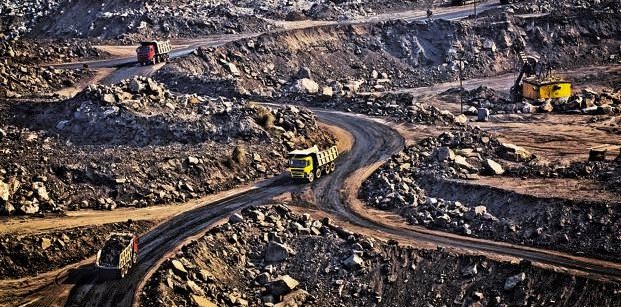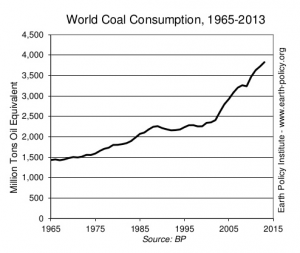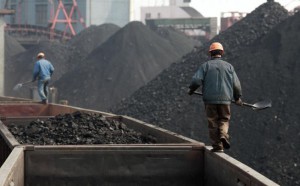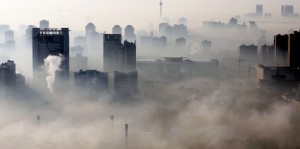The Great Transition – Closing Coal Plants

June 3, 2015 – We may wake up one morning in the not-too-distant future and realize that the world has reached a tipping point on coal.
So concludes the Earth Policy Institute in Chapter 3 of its upcoming report entitled The Great Transition: Shifting from Fossil Fuels to Solar and Wind Energy.
Use of this fuel will be declining worldwide, as it already is in many countries. Coal accounts for some 40 percent of global electricity generation. Natural gas accounts for 22 percent, hydroelectric power provides 16 percent, nuclear power some 11 percent, and oil just 5 percent. Wind, biomass, and solar make up the remainder.
No one knows exactly when coal will lose its top ranking as a source of electricity, but with world solar generating capacity growing in recent years at a phenomenal 60 percent annually and wind by more than 20 percent, use of the black rock that led the world into the industrial age may decline even faster than many in the energy field expect.
Coal takes a heavy toll in each phase of its journey from the ground to the smokestacks of power plants and beyond. For coal miners themselves, the price is all too often black lung disease.
Official data show that 76,000 coal miners have died in the United States since 1968 from black lung disease, a preventable affliction caused by breathing coal dust—a disease for which there is no cure.
 In China, with many more mines and less safety oversight, 10 times as many people are thought to be living with black lung disease today, though because of underreporting, the number could be far greater. More directly, accidents in Chinese mines have claimed over a thousand lives in each of the past several years.
In China, with many more mines and less safety oversight, 10 times as many people are thought to be living with black lung disease today, though because of underreporting, the number could be far greater. More directly, accidents in Chinese mines have claimed over a thousand lives in each of the past several years.
Miners’ deaths are only the beginning of coal’s health burden. Coal burning is a major source of mercury—a potent neurotoxin—in the environment. In the world’s water bodies, mercury travels up the aquatic food chain and endangers human health via fish consumption.
Coal also contains lead, cadmium, arsenic, and other carcinogens that can enter the environment where coal is mined, washed, or burned. Breathing the sulfur dioxide, nitrogen dioxide, and particulate matter released to the air from burning coal increases a person’s risk of cardiovascular and respiratory diseases, including heart attacks and lung cancer.
In the United States, air pollution from coal-fired power plants is estimated to cause more than 13,000 premature deaths each year, mostly in the coal-dependent eastern swath of the country. Coal pollution is implicated in triggering over 20,000 heart attacks and 217,000 asthma attacks annually.
These figures are actually improvements over years ago, before regulations like the federal Clean Air Act and state laws reduced air pollution from coal plants, mostly by requiring scrubbers on smokestacks. The Clean Air Task Force estimates that such rules saved some 11,000 lives each year between 2004 and 2010. But there is still work to be done.
The death toll from bad air is famously high in China, where rates of cancer and cardiovascular diseases in severely polluted areas are soaring. New York Times Beijing correspondent Edward Wong writes: “Residents of its boom cities and a growing number of rural regions question the safety of the air they breathe, the water they drink and the food they eat. It is as if they were living in the Chinese equivalent of the Chernobyl or Fukushima nuclear disaster areas.”
 A recent study by Teng Fei at Tsinghua University estimated that coal burning led to 670,000 early deaths in China in 2012 from strokes, coronary heart disease, lung cancer, and chronic obstructive pulmonary disease.
A recent study by Teng Fei at Tsinghua University estimated that coal burning led to 670,000 early deaths in China in 2012 from strokes, coronary heart disease, lung cancer, and chronic obstructive pulmonary disease.
A Chinese government policy that gave communities north of the Huai River free coal to burn in boilers for heating created an unintentional experiment, allowing researchers to compare the longevity of people in areas with and without heavy coal use. Controlling for other factors, they found that the 500 million people living north of the river were paying a disturbingly high price for the free coal: their life spans were cut by an average of five years.
Until recently, conventional wisdom held that coal burning was at least an economic source of electricity. But a 2011 study led by Harvard Medical School professor Paul Epstein concluded that from the ground to the power plant, coal indirectly costs the U.S. economy an astounding $345 billion per year, largely because of the associated health care burden from air pollution and because of the climate change impacts.
This massive figure exceeds the market value of the coal itself. In other words, the indirect costs to society of coal use are greater than the direct costs. Incorporating these indirect costs would easily double or triple the price of coal-generated electricity, making lower-cost wind and solar electricity clear winners.
In late 2013, U.N. Secretary-General Ban Ki-moon urged the world to take much stronger measures to stabilize climate, describing it as “the greatest single threat to peace, prosperity, and sustainable development.”
Hardly a week goes by without another dramatic example somewhere in the world of how the changing climate is altering lives. Instead of discussing climate change in the future tense, now the discussion is all too often in the present tense. Any effort to stabilize the earth’s climate starts with closing coal plants simply because they are the leading source of carbon emissions worldwide.
Read the full report at www.earth-policy.org/books/tgt/tgtch3.
Download brief overview presentation in Powerpoint (33 slides, 12.0 MB)



